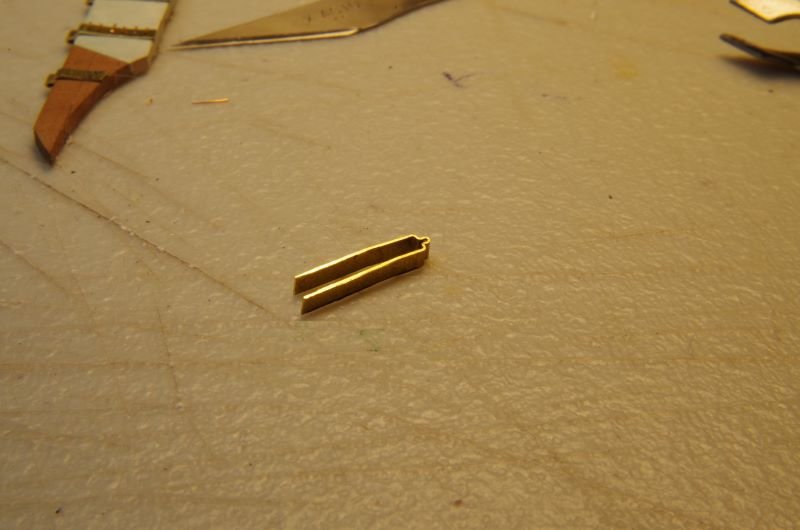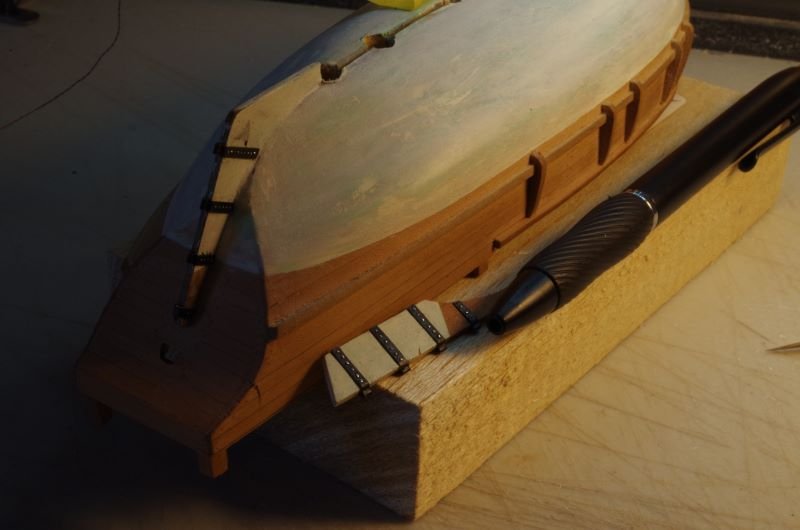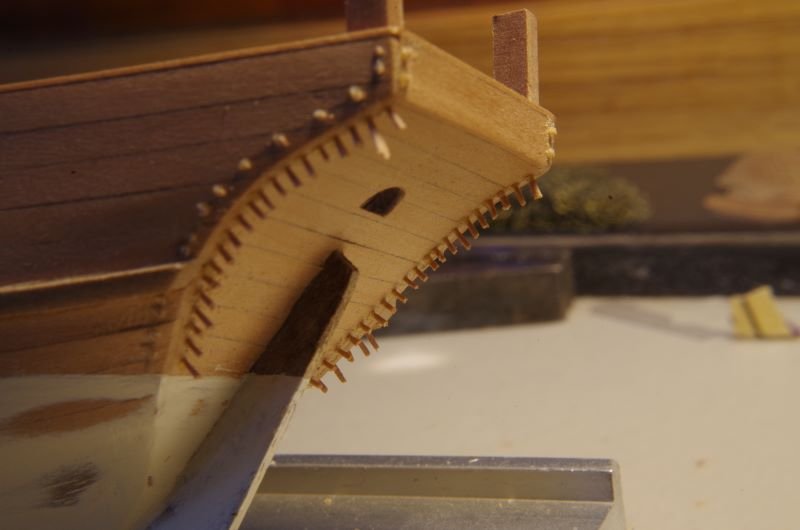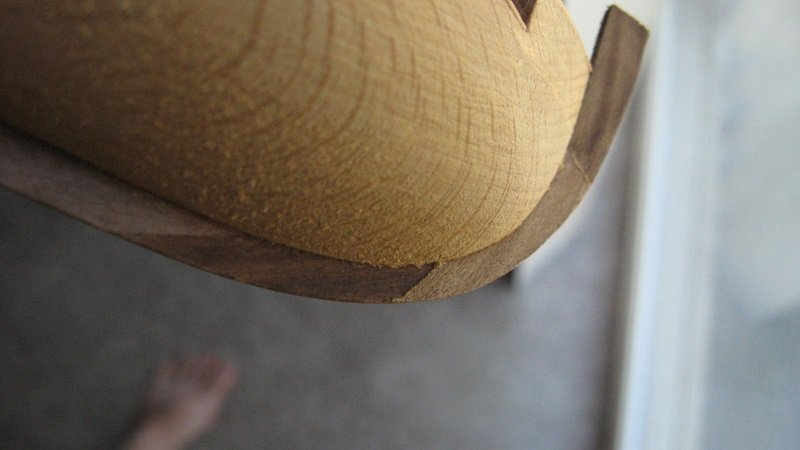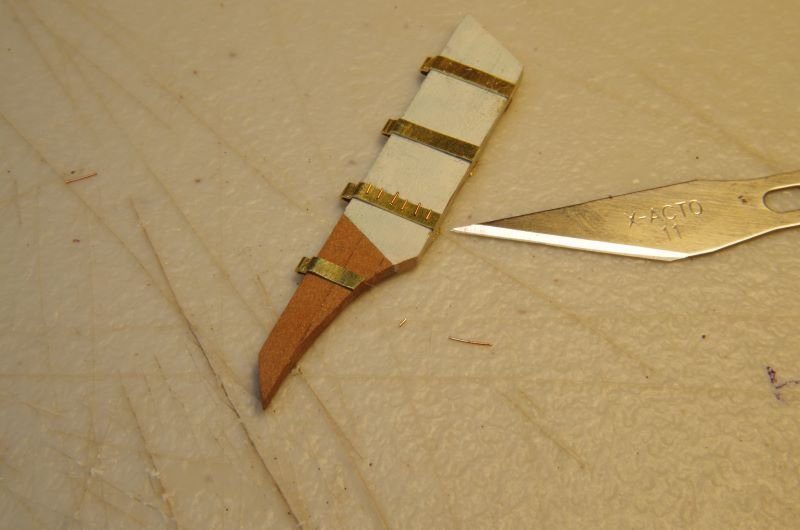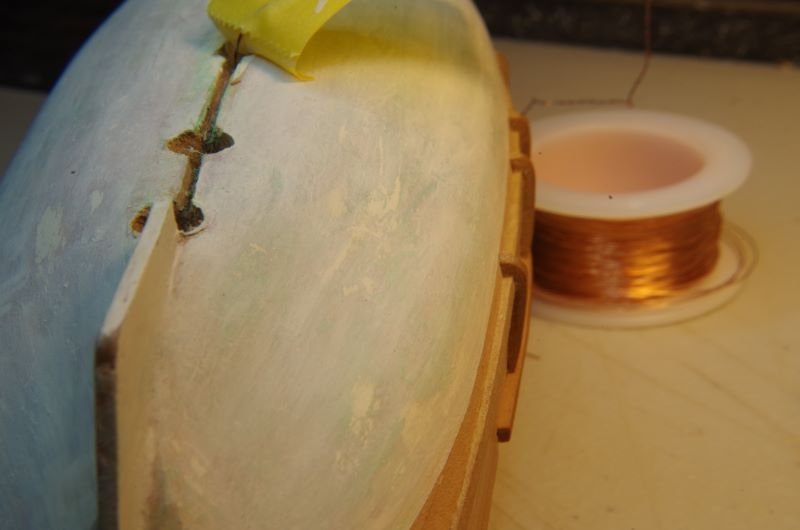-
Posts
491 -
Joined
-
Last visited
Content Type
Profiles
Forums
Gallery
Events
Everything posted by knightyo
-
I find the below to be the most enjoyable part of building a ship. Yes, I'm pretty sure I'm on the spectrum. These are pear, and from old pear blocks I had on hand. Rough-cut dowels were pulled through a standard progressive drawplate, and the ends sanded down to points allowing me to gently glue them into the predrilled holes. And then clipped/sanded down Just a photo of the topside of one of the pintles before the holes were drilled into the sides. And finally, the rudder assemblies are about complete. I'm not going to hang the rudder until the topside is complete and the model has been installed onto its base. The ends of the bolts were cut via a rolling motion under my X-acto blade which provided a tiny lip on the ends. They were then inserted into the pintles/gudgeons with a bit of superglue; overall, they hold the pintles/gudgeons more securely than I thought they would. I'm trying to decide whether or not they should be blackened or left bare. Each one of them reflects light at a different angle, so while it's fun to show that I created such small bolts, it's also frustrating, in that they don't look uniformly placed. I think I'll eventually prime/paint over them as they should be black in color anyway.
-
Ok, that's just shocking. I'd nervous to steer that ship on a lake. lol Alan
- 796 replies
-
- speedwell
- syren speedwell
-
(and 1 more)
Tagged with:
-
I see a recipe for kittens with a cat in both bow and stern; I see that one of them also knocked one of the checkers. down. I also like the tombstone cutaways. Everything looks fantastic. Alan
- 796 replies
-
- speedwell
- syren speedwell
-
(and 1 more)
Tagged with:
-
Hello, Gregory was exactly right. Below is a photo of my mini-Mamoli Nina. The keel parts are glued into the pre-drilled groove all the way along the keel. Since the keel will be painted below the waterline, it doesn't really matter what pattern of pieces you cobble together down there as long as they are all snug in the groove, and against each other. It also helps to install pieces which stick out too far as well, so the entire keel/stem can be sanded down as one unit after the glue dries. Alan
- 14 replies
-
- Solid hull
- Bregante
-
(and 1 more)
Tagged with:
-
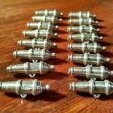
Warship identified off Florida coast 3 centuries after it sank
knightyo replied to Gregory's topic in Nautical/Naval History
They were just experimenting with fiberglass cannons. Alan -

Hawker Hurricane Mk. I by ccoyle - Halinski - 1/33 - CARD
knightyo replied to ccoyle's topic in Non-ship/categorised builds
I'd wager that your shipbuilding experience creating stealers had an influence on this solution. Alan -
Hello Kai, Since you enjoyed the Hornblower books, I would like to recommend the series by Patrick O'Brien which covers the same era, if you haven't already read them. That series of books is so enjoyable to read that many people read the entire series annually. Alan
-
From one Oregon introvert to another, welcome aboard! Alan
-
There are also mini LED's that flicker, simulating fire, that one could install in the fireplace if one wished to go overboard (I couldn't help myself) with the build. Alan
- 796 replies
-
- speedwell
- syren speedwell
-
(and 1 more)
Tagged with:
-
Metalwork around the rudder has been slowly taking place, and the straps are loosely placed on the rudder. They will be further shaped to the rudder and blackened before being permanently affixed (no idea how I'm going to permanently affix these. The wire bolts won't really have any strength long-term, so am really pondering this one). I had quite a learning curve in learning how to uniformly fashion the straps; many, many scrap pieces throughout. The photo also shows the bits of 30 ga wire that will be made into bolts. I'm just laying them down on the strip in the middle to see how the thickness of the wire will look from a scale perspective. I'm thinking of having 2 bolts per plank. The rudder is basically made up of 3 planks. I've also been experimenting with the finish on the hull. Goal is to try and make the finish appear to be as "real/aged" as possible, so there are a lot of green/brown washes on there now in addition to other white washes. The plan is to have shellac on the model, and I'm thinking of extending that down all around the acrylic on the hull as well to give it a bit of a wet/shiny appearance. Still debating that one, however. The gouges in the hull are for the brass tubing in which the lighting will run through from the ship down into the stand where the power source will be. When the tubing has been installed, the keel will be replaced and everything tidied up.
-
That's actually perfect. If you decide that you've sanded too much off, it's easy to reapply. I applied/removed acrylic to the hull of my Nina for a long, long time until I finally ended up with the look that I liked (applied different wash "layers" with slightly different colors as well. You might be able to get a pretty nice effect by applying washes of greys/greens/browns, showing not only the standard wear of the black, but also the effects of a boat that has been in the water with sea life). As Baker mentioned, it would probably be best to practice on scraps first. It's all your personal choice, however. The model is looking great! Alan
- 392 replies
-
That must be the intro to the fight scene.
- 796 replies
-
- speedwell
- syren speedwell
-
(and 1 more)
Tagged with:
-
Yes! With a flashlight whilst also swearing. Now THAT would be an authentic scene.
- 796 replies
-
- speedwell
- syren speedwell
-
(and 1 more)
Tagged with:
-
You will have to let us know when this moving comes out. It will really be fun to see the ship modeling part, knowing that you helped! It makes me wonder if any of the cast will be drawn to the hobby as a result of seeing your models, the process, etc. (Your Speedwell is looking absolutely stunning) Alan
- 796 replies
-
- speedwell
- syren speedwell
-
(and 1 more)
Tagged with:
-
This gave me a good laugh. I guess the good part about it is that a guy would never keep bits and pieces and assorted sawdust on his is table; he'd clean everything up after each session, resulting in a nice and uncluttered work area. The only wood I'd never work with is ebony. I've used it once, and vowed never again. Your project looks fascinating, and I do hope you continue to post your progress. I think a lot of build logs eventually get a comment the builder isn't thrilled with; it's just a function of so many different people from so many different backgrounds/demographics, etc. I've noticed my own posts are different in tone depending upon the time of day and the amount of caffeine in my system. I think the pros of having so many positive and helpful posts however, outweighs the cons of occasional posts which come across as off key. Alan
-
I love the addition of the inlays! They look great. I'm wondering if you want to do the same type of thing with the doors? The inlays are so well done that the doors almost detract from them. I only offer this as an opinion that is probably not held in the majority. I am a master of going down rabbit holes and never finishing my projects. Alan
-
Same here. I think I've even asked about them before, and was told the reason as to why they were no longer available. Of course, I've forgotten the reason. Alan
-
Welcome from Oregon, land of eternal sunshine. What? Alan
-
Chuck, just brainstorming here, but I loved the look of the framing/shadowbox you had on the Confederacy. If you provided that as an option on the POB, that might appeal even more to builders, as it could still have the look of a fully framed model as well. Kind of the best of all worlds for a lot of modelers. Alan
-
It almost feels like someone who is confident enough to tackle a POF would also be the type of person who would loft and cut their own frames. I'm thinking you might have a larger pool of potential customers if you don't supply the wood, but do offer all of the templates needed for someone to cut their own frames, with very detailed instruction on how to cut/shape the difficult areas (full-color photos/instructions, sexy book cover, etc). I'll bet you could net out higher if you sold books at 300 bucks a pop (and low time investment in printing) instead of full kits at 2 grand (and a lot of time burned in creating material).. I could also see a lot of modeler's requesting a book (or set) as a Christmas gift from their spouse at 300 bucks a pop, but would not have success in asking said spouse to drop a couple grand for a kit. If you found the right publisher and right mailing list, you might hit the jackpot. I've got a number of expensive books in my collection, but have no intention on creating the models; I just love having the books, looking at the photos, and knowing I could build the model some day if I ended up with an unexpected bonanza of free time. If I were to tackle a POF, I could see myself paying for instructions/templates, but not the actual wood that I could cut/sand/shape myself. The wood type is a limiter as well. There would probably be people who might be interested in the kit, but only if it's in swiss-pear, etc. At this point in the game, if it were me, I'd create one or two kits and market them here and on your website, knowing that they would probably eventually sell, and then just replace them in stock one at a time as they do sell, so you could eventually recoup your investment, and also have a nice, random income source for as long as you want. I think that in theory, with the right marketing, you could go either way; it would just be far less time consuming to create books than kits. EDIT: I would also absolutely offer this as a POB kit. 2nd EDIT: Also as a miniature navy board project. lol Alan
About us
Modelshipworld - Advancing Ship Modeling through Research
SSL Secured
Your security is important for us so this Website is SSL-Secured
NRG Mailing Address
Nautical Research Guild
237 South Lincoln Street
Westmont IL, 60559-1917
Model Ship World ® and the MSW logo are Registered Trademarks, and belong to the Nautical Research Guild (United States Patent and Trademark Office: No. 6,929,264 & No. 6,929,274, registered Dec. 20, 2022)
Helpful Links
About the NRG
If you enjoy building ship models that are historically accurate as well as beautiful, then The Nautical Research Guild (NRG) is just right for you.
The Guild is a non-profit educational organization whose mission is to “Advance Ship Modeling Through Research”. We provide support to our members in their efforts to raise the quality of their model ships.
The Nautical Research Guild has published our world-renowned quarterly magazine, The Nautical Research Journal, since 1955. The pages of the Journal are full of articles by accomplished ship modelers who show you how they create those exquisite details on their models, and by maritime historians who show you the correct details to build. The Journal is available in both print and digital editions. Go to the NRG web site (www.thenrg.org) to download a complimentary digital copy of the Journal. The NRG also publishes plan sets, books and compilations of back issues of the Journal and the former Ships in Scale and Model Ship Builder magazines.



